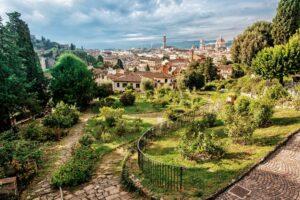Fodor's Expert Review Ponte Vecchio
This charmingly simple bridge was built in 1345 to replace an earlier one that was swept away by a flood. Its shops first housed butchers, then grocers, blacksmiths, and other merchants. But, in 1593, the Medici grand duke Ferdinand I (1549–1609), whose private corridor linking the Medici palace (Palazzo Pitti) with the Medici offices (the Uffizi) crossed the bridge atop the shops, decided that all this plebeian commerce under his feet was unseemly. So he threw out the butchers and blacksmiths and installed 41 goldsmiths and eight jewelers. The bridge has been devoted solely to these two trades ever since.
The Corridoio Vasariano ( Piazzale degli Uffizi 6, Piazza della Signoria 055/294883), the private Medici elevated passageway, was built by Vasari in 1565. Though the ostensible reason for its construction was one of security, it was more likely designed so that the Medici family wouldn't have to walk... READ MORE
This charmingly simple bridge was built in 1345 to replace an earlier one that was swept away by a flood. Its shops first housed butchers, then grocers, blacksmiths, and other merchants. But, in 1593, the Medici grand duke Ferdinand I (1549–1609), whose private corridor linking the Medici palace (Palazzo Pitti) with the Medici offices (the Uffizi) crossed the bridge atop the shops, decided that all this plebeian commerce under his feet was unseemly. So he threw out the butchers and blacksmiths and installed 41 goldsmiths and eight jewelers. The bridge has been devoted solely to these two trades ever since.
The Corridoio Vasariano ( Piazzale degli Uffizi 6, Piazza della Signoria 055/294883), the private Medici elevated passageway, was built by Vasari in 1565. Though the ostensible reason for its construction was one of security, it was more likely designed so that the Medici family wouldn't have to walk amid the commoners. Take a moment to study the Ponte Santa Trinita, the next bridge downriver, from either the bridge or the corridor. It was designed by Bartolomeo Ammannati in 1567 (probably from sketches by Michelangelo), blown up by the retreating Germans during World War II, and painstakingly reconstructed after the war. The view from the Ponte Santa Trinita is also beautiful, which might explain why so many young lovers hang out there.
READ LESS







